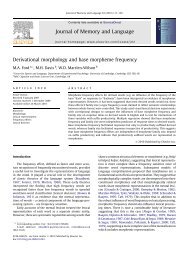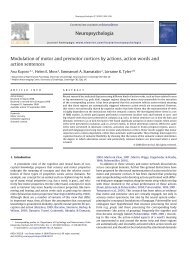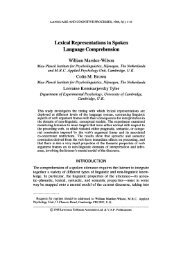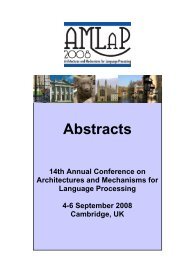Towards a psychological basis for a theory of anaphora - Centre for ...
Towards a psychological basis for a theory of anaphora - Centre for ...
Towards a psychological basis for a theory of anaphora - Centre for ...
Create successful ePaper yourself
Turn your PDF publications into a flip-book with our unique Google optimized e-Paper software.
pronoun made contact with its antecedent, there should<br />
be a facilitation <strong>of</strong> a lexical decision about the probe<br />
related to that antecedent. If, <strong>for</strong> example, mapping<br />
was achieved at the probe position immediately following<br />
the pronoun, then, <strong>for</strong> sentence (la) above, responses to<br />
"dog" should be facilitated relative to responses to<br />
"dog" in the same probe position in (lb), where the<br />
pronoun indexes the sailor rather than the cat. This<br />
would give us an estimate <strong>of</strong> the time-course <strong>of</strong> a basic<br />
anaphor ic mapping process.<br />
The results provided no evidence <strong>for</strong> a differential<br />
facilitation <strong>of</strong> the type we had hypothesized. Across<br />
the four probe positions in the second clause,<br />
decision-times varied between 620 and 640 msec. This<br />
reflects some degree <strong>of</strong> facilitation <strong>of</strong> the probes,<br />
since they are being responded to faster than in the<br />
control conditions cited above. But there was no sign<br />
<strong>of</strong> any differential facilitation as a function <strong>of</strong> the<br />
relationship <strong>of</strong> a probe to the pronoun, at any <strong>of</strong> the<br />
four positions. To the extent that facilitation<br />
reflects the activation <strong>of</strong> the semantic regions<br />
associated with the potential antecedent NPs, then these<br />
results suggest that both antecedents were being<br />
activated during the analysis <strong>of</strong> the second clause,<br />
irrespective <strong>of</strong> which antecedent was actually indexed by<br />
the pronoun occurring at the beginning <strong>of</strong> that clause.<br />
This interpretation <strong>of</strong> the results is <strong>of</strong> course<br />
preliminary, since a number <strong>of</strong> additional control<br />
studies need to be run. Nonetheless, it is clear that<br />
there is no support here <strong>for</strong> the view <strong>of</strong> pronoun<br />
resolution which had motivated us to run the experiment<br />
in the first place. Namely, the assumption that the<br />
resolution <strong>of</strong> a lexically unambiguous anaphoric pronoun<br />
is mediated by a unitary, all-or-none process, which<br />
sorts through the set <strong>of</strong> possible antecedents until the<br />
only matching antecedent is contacted, and that the<br />
properties <strong>of</strong> that antecedent - and <strong>of</strong> that antecedent<br />
only - are then made available <strong>for</strong> the further<br />
processing <strong>of</strong> the utterance. If there were some<br />
discrete choice-point <strong>of</strong> this type, then we should have<br />
been able to detect a differential facilitation <strong>of</strong> the<br />
probe related to the pronoun at at least one <strong>of</strong> the<br />
probe locations.<br />
The analysis that fits the results best - that both<br />
antecedents are activated ' early in the second clause,<br />
and remain activated <strong>for</strong> at lea.st the next few words -<br />
is consistent with the picture <strong>of</strong> anaphar resoJutfon<br />
suggested by the other two experiments presented in this<br />
section. Accordinq .- to this view, the constraints on<br />
anaphor resolution that derive from the lexical<br />
properties <strong>of</strong> a pronoun are a relatively subaspect<br />
<strong>of</strong> the resolution process. The more dominant<br />
factor is what we have been calling pragmatic inference






